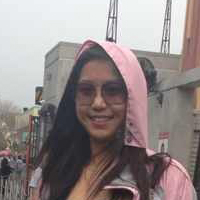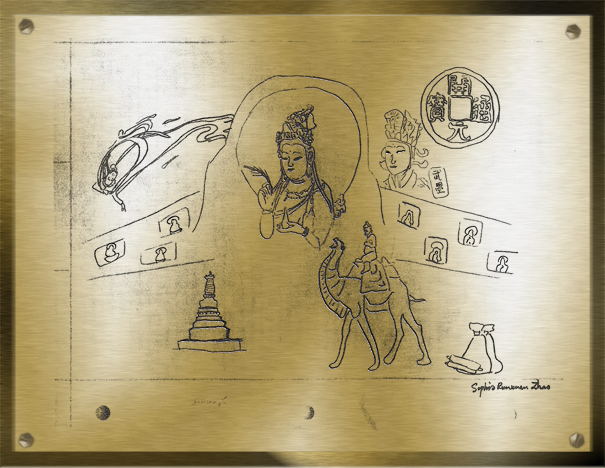| Time Period | Some time after 695 C.E when Empress Wu was building the Mogao Caves |
| Geographical Region | Dunhuang |
| List of Symbols |
|
Zhang Qian, minister of the Han Wu emperor, first opened up the Silk Road, which started from Chang’an and reached Dunhuang before it split up into three routes, which extended as far as India and Rome. Thousands of hundreds of merchants from China and central Asia had traveled along the ancient Silk Road to exchange merchandise from silk to gold and cattle to food. Among them, Sogdians, from Samarkand and Bukhara, emigrated from their original land to China and even influenced the history. In 755, An Lushan, a Sogdian general initiated a rebellion that weakened the reign of Tang emperor and changed the course of Chinese history.
This golden plague emphasizes on the famous city of Dunhuang, the hub of Silk Road, under the reign of Empress Wu. Empress Wu, the only female emperor in Chinese history, was very important to the development of Buddhism in China. She was the first person who feminized the Avalokitesvara with her face and this change remains. Even at modern time, statues of Avalokitesvara found in China are portrayed as a woman instead of man as in its Indian origin. In the middle of the plague, there is a figure of a female Avalokitesvara, indicating the time of the plague was sometime after empress Wu had came to power. In order to emphasis the time of the plate was during Empress Wu’s sovereignty and that it is her face on the statue of Avalokitesvara, a portrait of Empress Wu was presented next to the Bodhisattva and her reign name, Wu Zhao, was written on the lower left.
To further present the location of the plague, Mogao caves are depicted next to the Bodhisattva and small Buddha statues can be seen in each cave. To specify the Mogao caves in Dunhuang, the white horse pagoda was drawn on the left bottom of the plague. White horse pagoda was built in 384 in Dunhuang to commemorate the white horse of the Buddhist monk who brought Diamond sutra to China. This is a symbol that shows the Buddhist culture as well as the geographic region of Dunhuang. Another symbol that helps identify Mogao caves is the flying fairy figure, Aspara, on the top left.
The main character in this plague is the Sogdian merchant on the right bottom. He is riding on his camel, with bags of wheat and bolts of silk behind him. Though coin money has been invented centuries ago, silk and wheat were still among the most popular currencies along the Silk Road. However, in order to narrow down the historical time of the plague, the High Tang currency, Kaiyuan Tongbao, is shown on the right top of the plague. Kaiyuan Tongbao, first issued by Gao Zong in 621, was the main coin issued by Tang and was used until 845 when Emperor Wuzong changed it to copper bells and gongs.
Over all, with all the symbols depicted on the plague, viewers from later time should be able to identify the ‘who’, ‘when’ and ‘where’ of the plaque.

SOPHIA RUNXUAN ZHAO is a member of University of Rochester, class 2017. She is a Biomedical Engineering Major studying an Asian American History Cluster. Her major areas of interest in Ancient Chinese History are High Tang (Golden Plague Project) and Ming dynasty (Fictional Bibliography). More by Runxuan
